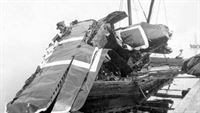Фотографии
-
Регистрационный номер: D-1158 German pilot Paul Baumer beside his Sausewind, D-1158. Designed by Walter Gunter, the aircraft sported an elegant elliptical wing and a smooth plywood monocoque fuselage. Gunter and his brother Siegfried Joined Heinkel after Baumer’s death, the Sausewind becoming the blueprint for the innovative He 70 and, ultimately, the He 111 bomber.
Самолёты на фотографии: Baumer B.II Sausewind - Германия - 1925
-
The second Rofix prototype, c/n 23, in its Turkish markings and the legend ‘‘Rohrbach Rofix” displayed diagonally across the rear fuselage. Note the lack of dihedral on the wings. With the first prototype damaged beyond repair in January 1927, everything was riding on the success of the second in Turkish acceptance trials in July the same year.
Самолёты на фотографии: Rohrbach Ro.IX Rofix - Германия - 1926
-
The second Rohrbach Rofix prototype, c/n 23, in Turkish markings at Kastrup in Copenhagen for the type’s acceptance trials in July 1927. The Rofix was designed specifically to a Turkish requirement for a fighter to replace its ageing Spad S.XIII biplanes. The Turkish Navy also acquired two Rohrbach Ro IIIa Rodra flying-boats in 1926.
Самолёты на фотографии: Rohrbach Ro.IX Rofix - Германия - 1926
-
A rare photograph of the first prototype, c/n 22, during a demonstration flight. The Rofix was competing for the Turkish order with a number of French designs and the German Junkers K 53, a militarised version of the company’s A 35, Turkey having established a relationship with Junkers with the acquisition of A 20s in 1925.
Самолёты на фотографии: Rohrbach Ro.IX Rofix - Германия - 1926
-
Another photograph of the first prototype in flight, this time with pronounced wing dihedral. The aircraft appears to be painted in a single dark colour overall and have the legend “Rohrbach Rofix” applied to the fuselage forward of the cockpit. Note the BMW VI engine’s unfaired radiator protruding from the underside of the fuselage.
Самолёты на фотографии: Rohrbach Ro.IX Rofix - Германия - 1926
-
In 1927 internationally renowned aviator Ernst Udet, then working as a freelance pilot, made several trips to Copenhagen to participate in the Rofix’s test-flying programme. He is seen here in the cockpit of the first prototype, the unpainted fuselage of which carries the legend “DANSK PROVELUFTFARTOJ” (Danish Test Aircraft).
Самолёты на фотографии: Rohrbach Ro.IX Rofix - Германия - 1926
-
The announcement from Rohrbach on the crash of c/n 23 stated that "the cause of the crash can only be guessed, but it is probable that the 35 or more revolutions of the machine made Baumer nervous”, to which British magazine The Aeroplane responded: "One can hardly imagine a pilot of Herr Baumer’s experience and proved bravery becoming ‘nervous’”.
Самолёты на фотографии: Rohrbach Ro.IX Rofix - Германия - 1926
-
A company three-view of the Rofix dated May 15, 1926. The type’s spinning characteristics caused some concern; the dihedral of the wings was altered several times to remedy the problem, and to address the fact that the Rofix was deemed too stable to offer the manoeuvrability required in a fighter.
Самолёты на фотографии: Rohrbach Ro.IX Rofix - Германия - 1926
Статьи
- -
- A.Arthy - Dieppe. The Luftwaffe Perspective
- A.Grandolini - On the wings of the Hansa (3)
- G.Smith - Pan Am's "Rogue" Atlantic Clippers
- K.Hayward - The Stop & Go Show
- K.Lande - Flash!
- L.Andersson - Turkish dismay
- L.Hellstrom - Sabena's Congo Ventilators
- M.Bearman - The other sound barrier
- N.Stroud - How quiet is our STOL?
- P.Davidson - Off the Beaten Track...
- P.Jarrett - Lost & Found
- R.Lezon, S.Rivas - The patagonian eagle
- T.Singfield - "A very nasty situation..."
- V.Flintham - Rover David (2)







